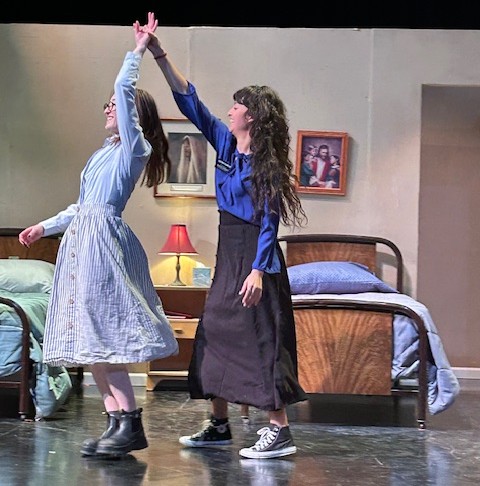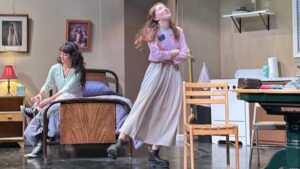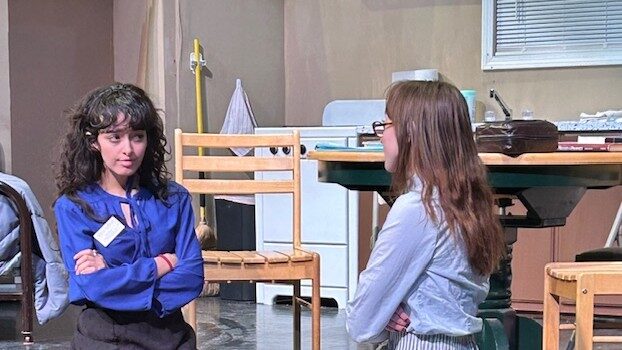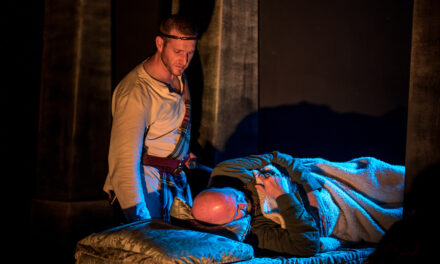SALT LAKE CITY — On February 21st Morag Shepherd’s The Big Quiet, premiered at the Rose Wagner Center in Salt Lake City. This play is a restrained yet powerful meditation on faith, self-doubt, and companionship. Produced by PYGmalion Theatre Company and directed by Tamara Howell, the play immerses audiences in the claustrophobic world of two LDS sister missionaries stationed in 2005 San Diego. With a script deeply rooted in Shepherd’s own missionary experience, The Big Quiet captures both the weight of institutional devotion and the undercurrents of personal rebellion within a rigid belief system.
At the heart of the production is the relationship between Sister García (Juls Marino) and Sister Roberts (Lily Hilden). Confined within their shared apartment, the two characters navigate the strictures of missionary life, their interactions oscillating between companionship, tension, and the unspoken yearning for something beyond the framework they have pledged themselves to uphold. Shepherd’s script resists easy categorization—her dialogue is neither an indictment of nor an endorsement of the LDS Church, but rather a layered exploration of faith as both comfort and constraint. The play’s success lies in its ability to depict the psychological toll of expectation, self-policing, and suppressed longing with quiet precision.
The minimalist staging, rather than limiting the play’s impact, amplifies its emotional intensity. Howell’s direction ensures that the audience feels the weight of the apartment’s physical and ideological confinement, making each glance toward the door or prolonged silence between the characters resonate with meaning. The set design—a faithful recreation of an LDS missionary apartment—serves as an extension of the play’s themes. From the well-worn copies of The Book of Mormon, the portrait of Gordon B. Hinkley, to the omnipresent framed depictions of Jesus in Eurocentric iconography, the space itself becomes a character, reinforcing the tension between faith’s comforting familiarity and its suffocating omnipresence.
The music design plays a crucial role in shaping the play’s atmosphere. The transitions and prelude consist of violin classical music that initially evokes the reverence of church music but occasionally takes on a frantic quality. This shift mirrors the evolving emotional and mental states of the sister missionaries, underlining their internal struggles and moments of turmoil as they navigate their faith and personal identities.

The Big Quiet at PYGmalion Theatre Company closes March 8, 2024. Photo by Robert Holman.
Marino and Hilden deliver performances that transcend mere doctrinal discourse, embodying the complexity of belief and rebellion with striking authenticity. Marino’s Sister García exudes an undercurrent of defiance, her small acts of resistance feeling monumental within the tightly controlled world she inhabits. Hilden’s Sister Roberts, in contrast, clings to order, her adherence to the rules masking a deeper vulnerability. Their chemistry makes the unfolding drama compelling, and their performances elevate the play’s philosophical inquiries into deeply personal stakes.
Salt Lake City provides a particularly charged backdrop for this production. As the heart of LDS culture, the city frames The Big Quiet as both a reflection and a provocation. Within this context, the play’s depiction of missionary life—often idealized within local discourse—gains added significance. The work challenges audiences to consider the space between faith and institutional expectation, between personal spirituality and the performative aspects of religious devotion. This tension is heightened by the city’s broader cultural landscape, where the intersection of tradition and self-discovery remains an ongoing negotiation.
I found myself writing down how many times Sister García referred to Sister Roberts as a “little bird,” “parrot,” she even calls her “little chirp chirp.” It dawned on me, almost immediately, that it was an important motif in the play. The symbolism of the little bird in The Big Quiet aligns with the themes of captivity, repression, and longing for freedom found in both Charlotte Perkins Gilman’s The Yellow Wallpaper and Stephen Sondheim’s Sweeney Todd: The Demon Barber of Fleet Street. In all three works, female characters are metaphorically likened to birds, emphasizing their vulnerability and confinement within patriarchal or oppressive systems.
In The Yellow Wallpaper, the narrator—a woman suffering from what her husband deems nervous hysteria—is subjected to the “rest cure,” which confines her to a room where she slowly loses her grip on reality. She frequently imagines herself as one of the trapped women she sees within the patterns of the wallpaper, stating, “I sometimes fancy that in my condition, if I had less opposition and more society and stimulus—but John says the very worst thing I can do is to think about my condition, and I confess it always makes me feel bad” (Gilman, 1892, p. 5). The narrator, much like a caged bird, is rendered powerless by external forces that dictate her existence.
Similarly, in Sweeney Todd, Johanna, the young woman kept captive by Judge Turpin, sings “Green Finch and Linnet Bird,” where she explicitly compares herself to a bird in a cage, asking, “If they sing for pleasure, what’s wrong? If they sing for pleasure, why not mine?” (Sondheim, 1979). This moment underscores her own imprisonment—both physically, under Turpin’s control, and emotionally, within a world where she has no agency. Her song reflects her yearning for escape, a desire that mirrors Sister Roberts’ potential internal conflict in The Big Quiet.

The cast of The Big Quiet, photo by Robert Holman.
Sister Roberts, frequently referred to as little bird by Sister García, exists in a similarly constricted space—trapped not only by the physical confines of their shared missionary apartment but also by the expectations of faith and obedience imposed on her by the LDS Church. Like Johanna, she is a young woman navigating a world built to control her choices, and like the narrator of The Yellow Wallpaper, she may be unaware of the full extent of her own captivity. The term little bird reinforces her innocence and vulnerability but also foreshadows the looming question: will she, like Johanna, attempt to break free, or will she, like Gilman’s narrator, lose herself entirely in the world she has been conditioned to accept?
All three works use bird imagery to explore the psychological impact of restriction—whether it be in a patriarchal marriage, a controlling guardian’s home, or a religious structure that dictates one’s path. In The Big Quiet, the repetition of little bird suggests a duality: it is both a term of endearment and an acknowledgment of Sister Roberts’ fragile state. Like the women in The Yellow Wallpaper and Sweeney Todd, she is poised at the edge of self-awareness, and the audience is left to wonder whether she will find the courage to fly or remain confined within the cage built around her.
Ultimately, The Big Quiet is a play of silences as much as speech, of unseen forces as much as overt conflict. By resisting didacticism, Shepherd crafts a work that lingers. The questions presented remain long after the final blackout. In a city where faith and self-interrogation often exist in uneasy proximity, The Big Quiet is not just a performance—it is an invitation to reflection. For those willing to sit with discomfort and ambiguity, the play offers a haunting meditation on belief, doubt, and the quiet acts of defiance that shape our lives. For those exploring existentialism or patriarchy, it is an essential watch, particularly in a place where the weight of expectation—and the longing for escape—feels ever-present. While this play was not what I expected and I wish it had explored more of the complexities of why members choose to stay or leave it does explore important themes. The most profound moment of the show, for me, was the last scene where we were left with the ultimate question that the title of this play posits: one of the sisters faces out to the audience and asks, “Have you ever prayed and there was nothing—just quiet?”

These reviews are made possible by a grant from the Salt Lake County Zoo, Arts, and Parks program.





